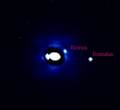87 Sylvia facts for kids

Image showing the positions of Remus and Romulus around 87 Sylvia on 9 different nights. The small image shows the potato form of 87 Sylvia.
|
|
| Discovery | |
|---|---|
| Discovered by | Norman Robert Pogson |
| Discovery date | May 16, 1866 |
| Designations | |
| A909 GA | |
| Main belt (Cybele) | |
| Orbital characteristics | |
| Epoch July 14, 2004 (JD 2453200.5) | |
| Aphelion | 563.679 Gm (3.768 AU) |
| Perihelion | 480.594 Gm (3.213 AU) |
| 522.137 Gm (3.490 AU) | |
| Eccentricity | 0.080 |
| 2381.697 d (6.52 a) | |
|
Average orbital speed
|
15.94 km/s |
| 352.763° | |
| Inclination | 10.855° |
| 73.342° | |
| 266.195° | |
| Physical characteristics | |
| Dimensions | 385×265×230 ± 10 km |
| Mass | 1.478±0.006×1019 kg |
|
Mean density
|
1.2 ± 0.1 g/cm³ |
| 0.027 m/s² | |
| 0.10 km/s | |
| 0.2160 d (5.183642 h) | |
| Albedo | 0.0435 |
| Temperature | ~151 K max: 223 K (-52°C) |
|
Spectral type
|
X |
| 6.94 | |
87 Sylvia is one of the largest asteroids found in the main asteroid belt. It belongs to a group of asteroids called the Cybele group. This asteroid is special because it was the first one known to have more than one moon.
Contents
Discovering 87 Sylvia
Sylvia was discovered by N. R. Pogson on May 16, 1866. He found it while working at an observatory in Madras (now Chennai), India.
How Sylvia Got Its Name
The name Sylvia was chosen by Pogson. He named it after Rhea Silvia, a character from ancient Roman myths. She was the mother of Romulus and Remus, two famous twin brothers in Roman stories. This is interesting because Sylvia itself later had two moons named Romulus and Remus!
What Sylvia Is Like
Sylvia is a very dark asteroid. Scientists think it's made of basic, old materials from when the solar system formed.
Size and Shape
Sylvia is quite large, shaped like a stretched-out potato. It measures about 385 kilometers (239 miles) long, 265 km (165 miles) wide, and 230 km (143 miles) thick.
How Heavy and Dense Is It?
Because Sylvia has moons, scientists could figure out its mass (how much "stuff" it has) and density (how tightly packed that "stuff" is). Its density is very low, only about 1.2 times the density of water. This means Sylvia might have a lot of empty spaces inside it. It could be anywhere from 25% to 60% empty space!
A Rubble Pile Asteroid
This low density suggests that Sylvia is a "rubble pile." Imagine an asteroid that was once broken into many pieces by a huge crash. Then, gravity slowly pulled those pieces back together, but they didn't fit perfectly, leaving lots of gaps. That's a rubble pile asteroid.
How Fast Sylvia Spins
Sylvia spins quite fast! It completes one full rotation on its axis every 5.18 hours. This means its surface at the equator moves at about 230 kilometers per hour (145 miles per hour). Its shortest side is the one it spins around.
Sylvia's Moons: Romulus and Remus
Sylvia has two small moons orbiting it. They are officially named (87) Sylvia I Romulus and (87) Sylvia II Remus. Just like in the myth, they are named after the children of Rhea Silvia.
Romulus: The First Moon
Romulus was the first moon discovered. It was found on February 18, 2001, using the Keck II telescope. It's about 18 kilometers (11 miles) wide. Romulus orbits Sylvia at a distance of about 1,356 kilometers (843 miles). It takes about 3.65 days (87.59 hours) to complete one trip around Sylvia.
Remus: The Second Moon
Remus was found later, on August 9, 2004. It's smaller than Romulus, only about 7 kilometers (4.3 miles) wide. Remus orbits much closer to Sylvia, at a distance of about 706 kilometers (439 miles). It takes about 1.38 days (33.09 hours) to go around Sylvia once.
How the Moons Formed
Scientists believe that Sylvia and its two moons likely formed from the same event. It's thought that a large asteroid crashed, breaking into many pieces. Then, gravity pulled these pieces back together to form Sylvia, Romulus, and Remus. It's even possible there are other, smaller moons around Sylvia that haven't been found yet!
What It's Like on Sylvia's Surface
If you stood on Sylvia, both Romulus and Remus would look about the same size in the sky. Romulus, the farther moon, would appear a little bigger than Remus, the closer but smaller moon. Because Sylvia isn't perfectly round, how big they look might change slightly depending on where you are on its surface.
Since the moons orbit in a similar flat path, they would pass in front of each other (called an occultation) about every 2.2 days. Also, twice during Sylvia's 6.52-year journey around the Sun, the moons would block the Sun's light, causing an eclipse. The Sun would look much smaller from Sylvia than it does from Earth.
- Pogson, N. R. (1866), Minor Planet (87) Sylvia, Monthly Notices of the Royal Astronomical Society, Vol. 26, p. 311 (June 1866)
- Rubble-Pile Minor Planet Sylvia and Her Twins (ESO news release, August 2005) Includes images and artists impressions
- Adaptive Optics System Reveals New Asteroidal Satellite (SpaceDaily.com, March 2001) Includes a discovery image.
Images for kids
See also
 In Spanish: (87) Sylvia para niños
In Spanish: (87) Sylvia para niños


